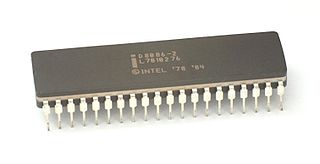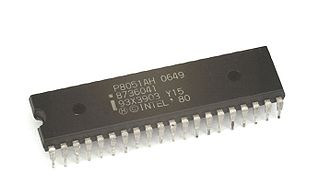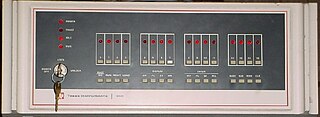
x86 is a family of complex instruction set computer (CISC) instruction set architectures initially developed by Intel based on the 8086 microprocessor and its 8-bit-external-bus variant, the 8088. The 8086 was introduced in 1978 as a fully 16-bit extension of 8-bit Intel's 8080 microprocessor, with memory segmentation as a solution for addressing more memory than can be covered by a plain 16-bit address. The term "x86" came into being because the names of several successors to Intel's 8086 processor end in "86", including the 80186, 80286, 80386 and 80486. Colloquially, their names were "186", "286", "386" and "486".
In computer science, an instruction set architecture (ISA) is an abstract model that generally defines how software controls the CPU in a computer or a family of computers. A device or program that executes instructions described by that ISA, such as a central processing unit (CPU), is called an implementation of that ISA.

The Intel MCS-51 is a single-chip microcontroller (MCU) series developed by Intel in 1980 for use in embedded systems. The architect of the Intel MCS-51 instruction set was John H. Wharton. Intel's original versions were popular in the 1980s and early 1990s, and enhanced binary compatible derivatives remain popular today. It is a complex instruction set computer with separate memory spaces for program instructions and data.
The Intel x86 computer instruction set architecture has supported memory segmentation since the original Intel 8086 in 1978. It allows programs to address more than 64 KB (65,536 bytes) of memory, the limit in earlier 80xx processors. In 1982, the Intel 80286 added support for virtual memory and memory protection; the original mode was renamed real mode, and the new version was named protected mode. The x86-64 architecture, introduced in 2003, has largely dropped support for segmentation in 64-bit mode.
In computing, protected mode, also called protected virtual address mode, is an operational mode of x86-compatible central processing units (CPUs). It allows system software to use features such as segmentation, virtual memory, paging and safe multi-tasking designed to increase an operating system's control over application software.
x86 assembly language is the name for the family of assembly languages which provide some level of backward compatibility with CPUs back to the Intel 8008 microprocessor, which was launched in April 1972. It is used to produce object code for the x86 class of processors.
Fetching the instruction opcodes from program memory well in advance is known as prefetching and it is served by using a prefetch input queue (PIQ). The pre-fetched instructions are stored in a queue. The fetching of opcodes well in advance, prior to their need for execution, increases the overall efficiency of the processor boosting its speed. The processor no longer has to wait for the memory access operations for the subsequent instruction opcode to complete. This architecture was prominently used in the Intel 8086 microprocessor.
In computing, position-independent code (PIC) or position-independent executable (PIE) is a body of machine code that executes properly regardless of its memory address. PIC is commonly used for shared libraries, so that the same library code can be loaded at a location in each program's address space where it does not overlap with other memory in use by, for example, other shared libraries. PIC was also used on older computer systems that lacked an MMU, so that the operating system could keep applications away from each other even within the single address space of an MMU-less system.
The x86 instruction set refers to the set of instructions that x86-compatible microprocessors support. The instructions are usually part of an executable program, often stored as a computer file and executed on the processor.
Addressing modes are an aspect of the instruction set architecture in most central processing unit (CPU) designs. The various addressing modes that are defined in a given instruction set architecture define how the machine language instructions in that architecture identify the operand(s) of each instruction. An addressing mode specifies how to calculate the effective memory address of an operand by using information held in registers and/or constants contained within a machine instruction or elsewhere.
In computer engineering, an orthogonal instruction set is an instruction set architecture where all instruction types can use all addressing modes. It is "orthogonal" in the sense that the instruction type and the addressing mode may vary independently. An orthogonal instruction set does not impose a limitation that requires a certain instruction to use a specific register so there is little overlapping of instruction functionality.

The Western Design Center (WDC) 65C02 microprocessor is an enhanced CMOS version of the popular nMOS-based 8-bit MOS Technology 6502. It uses less power than the original 6502, fixes several problems, and adds new instructions. The power usage is on the order of 10 to 20 times less than the original 6502 running at the same speed; its reduced power consumption has made it useful in portable computer roles and industrial microcontroller systems. The 65C02 has also been used in some home computers, as well as in embedded applications, including implanted medical devices.
NAR 2 is a theoretical model of a 32-bit word computer created by Faculty of Mathematics of University of Belgrade professor Nedeljko Parezanović as an enhancement to its predecessor, NAR 1. It was used for Assembly language and Computer architecture courses. The word "nar" means Pomegranate in Serbian. Many NAR 2 simulators have been created — for instance, one was named "Šljiva" as that fruit grows in Serbia, while "nar" does not.
The task state segment (TSS) is a structure on x86-based computers which holds information about a task. It is used by the operating system kernel for task management. Specifically, the following information is stored in the TSS:

The TI-990 was a series of 16-bit minicomputers sold by Texas Instruments (TI) in the 1970s and 1980s. The TI-990 was a replacement for TI's earlier minicomputer systems, the TI-960 and the TI-980. It had several unique features, and was easier to program than its predecessors.
The PDP-11 architecture is a 16-bit CISC instruction set architecture (ISA) developed by Digital Equipment Corporation (DEC). It is implemented by central processing units (CPUs) and microprocessors used in PDP-11 minicomputers. It was in wide use during the 1970s, but was eventually overshadowed by the more powerful VAX architecture in the 1980s.

The ST6 and ST7 are 8-bit microcontroller product lines from STMicroelectronics. They are commonly used in small embedded applications like washing machines.
The PIC instruction set refers to the set of instructions that Microchip Technology PIC or dsPIC microcontroller supports. The instructions are usually programmed into the Flash memory of the processor, and automatically executed by the microcontroller on startup.

The STM8 is an 8-bit microcontroller family by STMicroelectronics. The STM8 microcontrollers use an extended variant of the ST7 microcontroller architecture. STM8 microcontrollers are particularly low cost for a full-featured 8-bit microcontroller.

The WD16 is a 16-bit microprocessor introduced by Western Digital in October 1976. It is based on the MCP-1600 chipset, a general-purpose design that was also used to implement the DEC LSI-11 low-end minicomputer and the Pascal MicroEngine processor. The three systems differed primarily in their microcode, giving each system a unique instruction set architecture (ISA).






